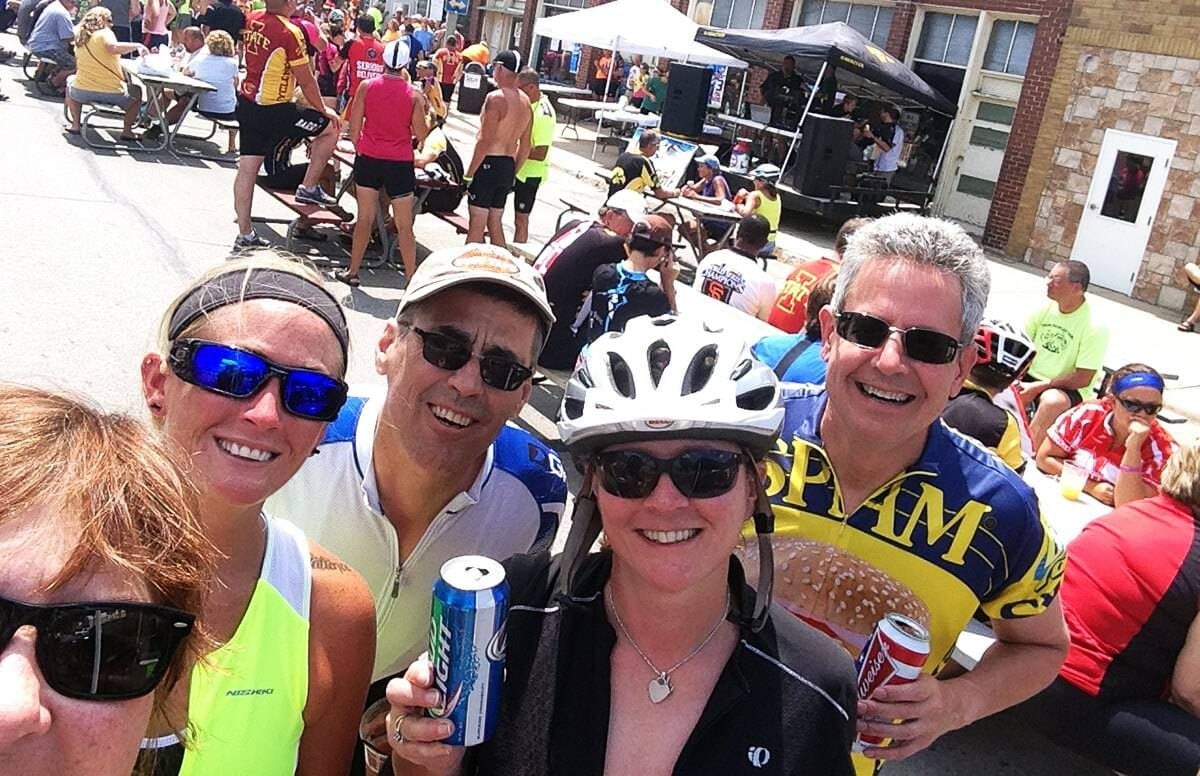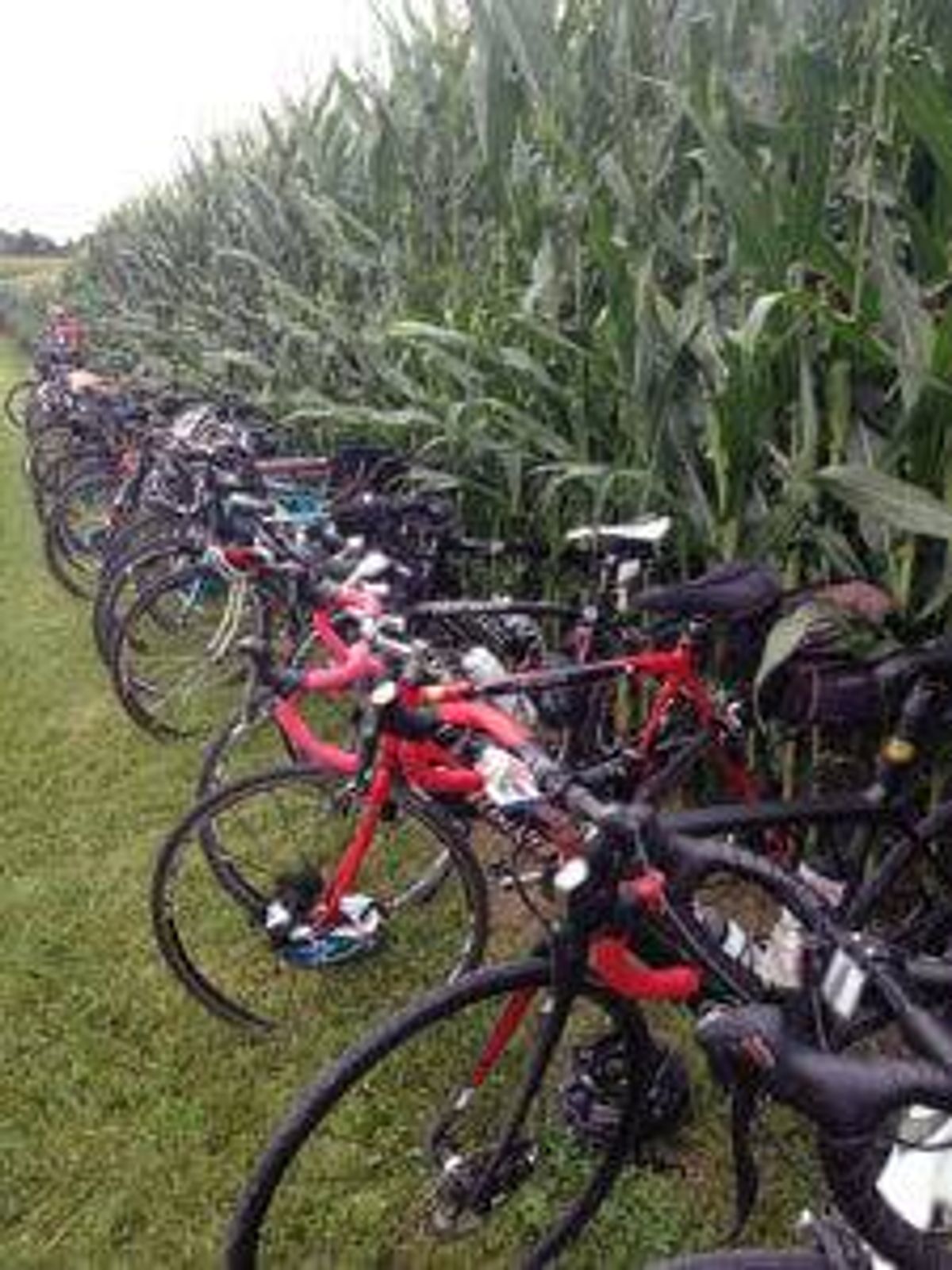The Bike Ride You Should Add to Your Bucket List
After resisting biking across Iowa, she's pedaled RAGBRAI for 20 years
It's the oldest, largest and longest recreational bicycle touring ride in the world. It's wild and friendly, exhausting and exhilarating, yet somehow relaxing. My friends and I call it "Summer Camp for Grownups." I’m talking about RAGBRAI — the (Des Moines) Register's Annual Great Bicycle Ride Across Iowa. For the past 44 years, the bike ride has traveled from the west side of Iowa to the Mississippi River on the east border during the last full week in July.

It's been part of the fabric of my life for 20 of those years.
At the RAGBRAI Bike Ride, We Are Family
For me, it all started — as all good ideas do — during happy hour. I worked at The Des Moines Register in the 1990s and had developed a pat response to the effusive praise I would hear about the ride: "I'm not spending a week of my precious vacation on a bicycle in Iowa."
Until that one happy hour with my co-workers when, inspired by several pitchers of beer, we revelers decided we would give it a try. That was 1996. And, along with several others in that merry band, I’ve been back every year since.
We've shared births, marriages, cancer battles and even death. We call ourselves Team Larry (named for our longtime driver, as we bring our own support vehicle). And we've become a one-week family.
Leaving California to Bike Iowa
Newspaper journalists at the core, the group has morphed, grown and faded over the years.

One of the stalwarts who's been there since the beginning was working at The San Jose Mercury News. Brad Kava knew someone who knew someone on Team Larry. Like all of us, he had no idea what to expect — but he decided to make the trek from California to ride his bike across Iowa anyway.
"I was so impressed with my first one that I did 19 in a row and never got tired of it," Kava says. "Since I first did it, I literally dream about it all the time. People are talking, singing, traveling by bike in all my dreams."
The exact route changes every year, to give Iowa Boy Scout troops and church casserole cooks across the state access to 10,000 hungry and thirsty Spandex-clad riders. But it's always west to east (it's tradition to dip your rear bike tire in the Missouri River and your front tire in the Mississippi).
"Coming from California to Iowa for RAGBRAI always makes me feel like I'm in a time when America is truly great," Kava says. "It's like going back in time. People open their homes and hearts to strangers. There is camaraderie among the riders and locals, and we're using the most pollution-free vehicles out there."
What You Need to Know About RAGBRAI
If RAGBRAI isn’t already on your bucket list, maybe it should be (and not so you can see what Kava's dreams are like — personally, I wouldn't go there). And this is a good year to go for it. The 2017 route (July 23 to 29) will travel the northern tier of Iowa and is the third-shortest and third-flattest in the ride's 44 trips across the state. Registration is open now, but maybe not for long. RAGBRAI has filled up for the past 20 years, says ride director T.J. Juskiewicz. Before you commit, he says, this is what you need to know:


- It helps to ask around. Start with you local bike shop or bike club. Find RAGBRAI veterans. Get their advice.
- Have a completely open mind. "If you like people and you like biking, you're going to enjoy it," Juskiewicz says.
- You'll be biking in a crowd. If you prefer to cycle a wooded trail alone or with a few friends, RAGBRAI is not for you. The roads on the route (almost all of them paved) are shut down and filled with riders three and four across, stretching as far as you can see ahead of you, with the same view behind. It's an awesome sight, but solitude does not exist. There are 10,000 week-long registered riders and a couple thousand more just along for a day or two. Learn to ride in a pack.
- You'll be camping. The few hotel rooms in the overnight rural communities are gone almost in the same breath they're announced, but RAGBRAI will haul your camping gear and bags from town to town and there are campsites set up in almost every open space in the overnight towns. Shower trucks are set up, high school locker rooms are opened for riders and the occasional local car wash has been outfitted with showerheads and makeshift curtains. That said: you're going to be sleeping in a tent. You'll also be so tired it won't make a difference.
- It's going to be hot. And humid. This is late July in Iowa. You are surrounded by cornfields and soybean fields, those acres of shimmering green rows soaking up the sunshine and seeming to exhale even more humidity. It's also going to be tailwinds and blue skies some days. Or rainy. This is late July in Iowa. Not to worry: You have nothing to do all day long but ride your bike.
- You can choose your own adventure. Some riders are on the road at sunrise and in the overnight town well before noon. Some start later and stop in every town to rest in the shade, grab a snack or a meal or dance to a DJ or a local band in the park. "There's no set way to start, no set way to finish. You can ride it any way you want to ride it,” Juskiewicz says. “Try not to set an agenda." Riders can find everything they need along the route — from food to bike mechanics. You might see a park, a museum, something to eat along the way. There are lawn chairs set up in shady farmyards.
- You don't need to bring food. Every town along the route, no matter how tiny, has food, friendly locals and Gatorade. And music and a beer garden. And folks who will let you stretch out on their lawn in the shade. And church ladies who have spent days and days before your arrival baking up some of the best pie you'll find anywhere. Pie is, in fact, one of the famous foods on RAGBRAI. And pork chops cooked over an open grill fueled by corncobs. Sandwiches, rib-eye steaks from the local cattlemen's association, sweet corn dripping in butter, ice cream churned with old John Deere farm motors, fruit smoothies, breakfast burritos and sometimes a juicy ripe tomato sandwich sold at the end of a gravel driveway outside a farm.
- You can party. Or not. RAGBRAI has long had a party reputation. If you want to find a party, you can. There are riders who stop in every town at the first bar on the right... unless it's on the left. Juskiewicz compares it to tailgating before a football game. Some tailgaters are there to see how many shots they can do before kickoff. For others, it's a time to cook out and spend time time friends and family.
- Train before you go. Though this summer will be the third-flattest ride in RAGBRAI history, there will be "serious challenges to your bottom and body," Juskiewicz says. Train. A good baseline before the ride is 500 miles. "It conditions your bottom. In one week on RAGBRAI, you will double your entire year's training,” he says. "There is no pain like a sore bottom."
- You don't need a fancy bike. Juskiewicz has seen riders on $100 bikes and $10,000 bikes. "As long as you're powering it yourself, you're welcome on RAGBRAI," he says.
- Everyone is welcome. The average age for a RAGBRAI rider is mid-40s, but you'll see riders of all ages and sizes. Sleek and speedy. Wobbly. Slow and chatty. Families on tandems and contraptions that look like something out of a Dr. Seuss book. Muscular twentysomethings racing past in a pack, music blaring. Bikers with tutus or flowers or cans of Spam affixed to their helmets. Most of them will be smiling. If not, they should get behind one of RAGBRAI's famous mantras: "If you're not having fun, lower your standards."

